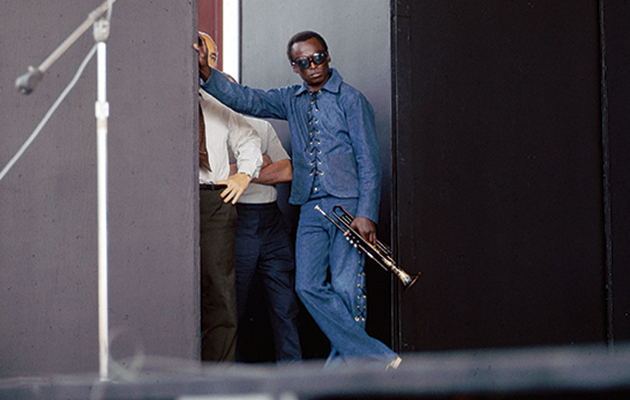A TRIBUTE TO JACK JOHNSON
Columbia, 1970
Produced by Teo Macero
A jam before Miles is even present kicks off this hugely enjoyable LP that’s even more funky and Hendrixy than Bitches Brew. Edited together from different sessions by different bands, even to the puzzlement of the recording personnel (Jack DeJohnette: “Am I on that one?”).
MICHAEL HENDERSON (BASS): Betty Davis brought Miles to see me when I was working with Stevie Wonder. Miles was looking for an electric bass: he was looking to get into more fusion, more funk. I knew I had the gig, when he came by and told Stevie Wonder, “I’m taking your fucking bass player.” The next day at his house, John McLaughlin, Billy Cobham and some of the guys showed up to rehearse some songs. We thought what we were going over in his living room was going to be what we were going to record, but we didn’t do any of that the next day. We got in the studio and Teo was doing his line check, and we were waiting for Miles, and John started playing [sings guitar riff]. I jumped in. Cobham jumped in. We were going for it, then Miles shows up. Teo was recording all the time, always. The next thing, Miles is running in with his trumpet. Herbie Hancock was recording upstairs and dropped by to say hello, but Miles directed him to come out and play. Herbie had a bag of groceries. Teo and the sound guy fixed up a Farfisa – on the record you can hear a noise when they plug it in. So Herbie put down his groceries, came in and started playing. That was where “Right Off” came from.
_________________
LIVE-EVIL
Columbia, 1971
Produced by Teo Macero
A curate’s egg – and a hard-boiled one. The proposed sequel to Bitches Brew turns into something else entirely. Short, meditative studio compositions from the Jack Johnson sessions are juxtaposed with longform electric jams from four nights at the Cellar Door, Washington DC.
JACK DEJOHNETTE: Live-Evil came about because Buddy Miles was playing with Elvin Bishop in a band called The Electric Flag and Miles wanted the kind of groove Buddy Miles had, but he wanted my technique. So I applied that kind of steady thing to Live-Evil. I’m glad they put out all three nights of it, because you can hear the development each night of the pieces. It was aggressive, but it was a searching thing: all those pieces with the exception of “Yesternow” were just one chord, so it shows what creative musicians can do with a groove and just one chord. You really have to come up with something else to make it interesting, and everyone in that band did – Airto Moreira, Gary Bartz and Michael Henderson. It’s a great tutorial in how to play on a vamp for 20 minutes and keep it interesting. Miles’ music continued like a suite live: he would cue the songs by playing the melody of the next piece and we would go into it – it was a continuous suite. The music wasn’t that difficult, but there was complexity in the feeling and the intellect, that gave it substance. Everything Miles did was groundbreaking… I was thrilled to be a part of that musical movement.



